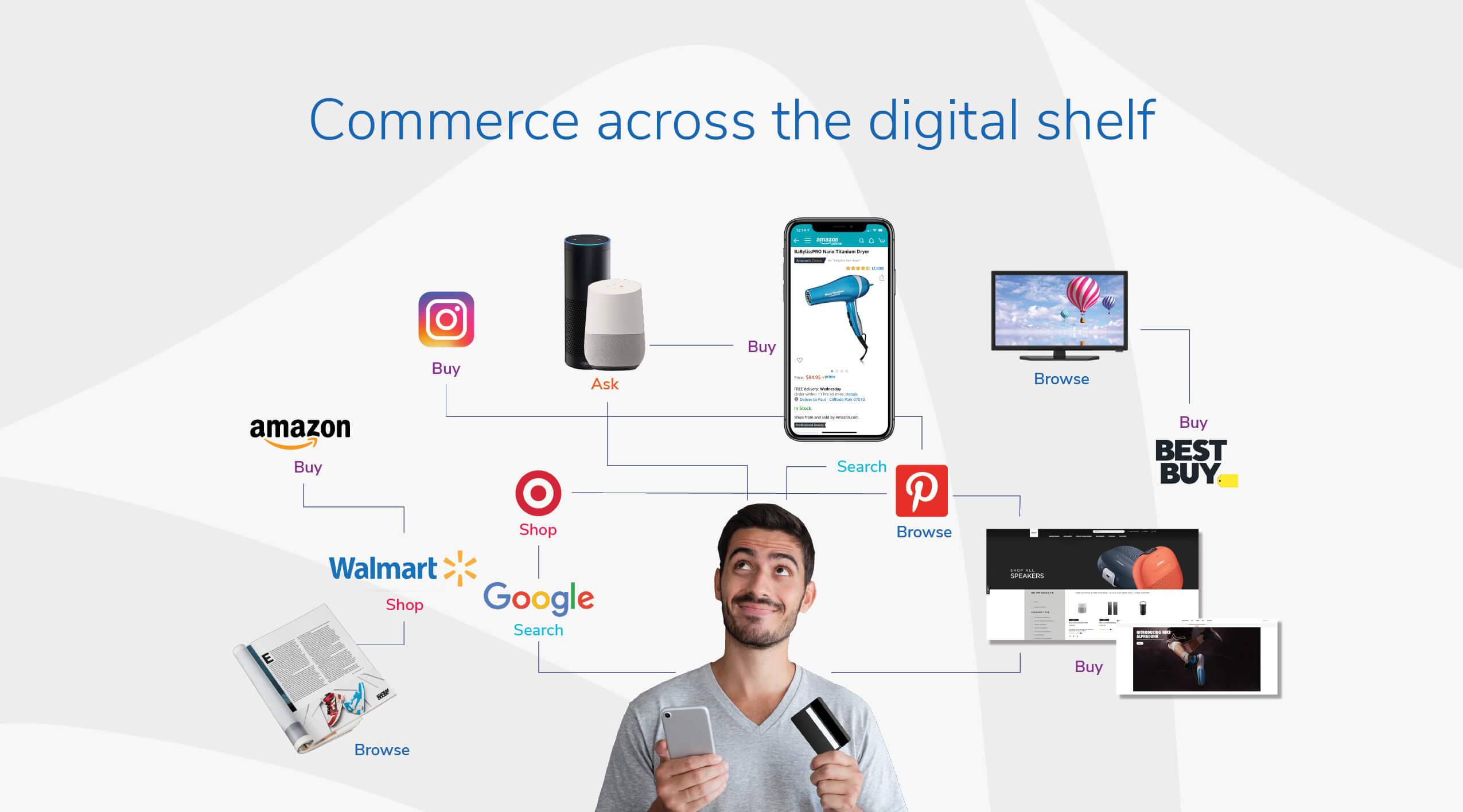How to win market share with product syndication
blog
March 31, 2020Reaching new channels, marketplaces, and data pools quickly is essential to compete and drive revenue today.
Consumers today have endless buying options and endless channels to research and shop for products. The need for digital commerce is essential during these challenging times. The omnichannel experience represents a seismic shift for marketers and commerce teams; forget everything you know about the path of the purchase. It’s all about to change.
Google research on the customer journey is eye-opening: Today’s shoppers have dozens—even hundreds—of touchpoints on the buying journey. Consumers expect to find the products they’re looking for on every channel they use and they expect the product information to be accurate, complete, and most of all consistent.
That presents a huge challenge for brands that want to expand their presence and grow their market share. If your products aren’t everywhere your buyers are researching, you’re losing sales to a competitor. And if your product experience is lackluster or inconsistent, you risk damaging your brand in the process.
Retailers don’t make the omnichannel experience easy. Brands and manufacturers are familiar with retailer roadblocks to getting your products on the digital shelf. Amazon, which is the starting point for 66% of online buying journeys, continually changes its PDP requirements and algorithms, so keeping your products both findable and shoppable is a major challenge. It’s the same story with other online marketplaces, wholesaler partners, data pools, and channel partners.
It’s clear that if your buyers are omnichannel, you need to be, too; getting there is the problem.
Manual content distribution doesn’t cut it
When each channel has its own content specifications, formats, and file type, distributing product information from spreadsheets can take hundreds of hours. Supplying your existing channels with updated, enriched content taxes your resources leaving nothing left for expansion.
Not only that, but it’s also a process ripe for human error. This results in lost revenue due to disapproved products, products pulled for inaccurate information, and even financial penalties assessed. No one has time for that.
Inefficiencies can be costly. Brands suffer decreased selling days from slow time to market and the inability to enter new channels or data pools efficiently. When revenue-driving opportunities open up, cumbersome manual processes requiring heavy IT support prevent brands and manufacturers from moving quickly to capitalize on them.
These challenges prevent expanding into new channels, remaining competitive, and growing market share.
Product content syndication solves the omnichannel challenge
Syndication automates the distribution of your product content feed across all your marketplaces, channels, data pools, and wholesalers. But it goes beyond simply managing your product information. It takes the burden off the supplier.

Benefits of syndication
Retailers and distributors want to give their customers unique shopping experiences. This puts the burden on your team to ensure a consistent product experience. With a syndication solution, you can activate the right content, enriched and optimized for each channel, from a single platform.
- Create a compelling product experience. Your product page replaces the physical shelf. It’s all about the digital shelf, so you need to deliver information-hungry buyers everything they need and pave a frictionless path to purchase. Make it easy to buy. Comprehensive product information, accurate and complete product data, engaging images and video, tutorials, virtual try-ons, and schematics can be managed and activated easily from one place.
- Optimize your product content for every channel. Businesses that provide an optimized omnichannel experience retain 89% of their customers compared to 33% of businesses with weak omnichannel engagement. Syndicating your product content lets you create multiple versions of your product content automatically in the approved formats ensuring consistency and accuracy.
- Expand your product reach and enter new markets quickly. A Gartner report by Simon James Walker stated that the volume of product data needed and the speed at which it must be delivered is increasing significantly. Brands need an end-to-end syndication solution to handle product catalog uploads quickly with approved templates when they’re ready to enter new markets. Syndication eliminates any guesswork and missing data that delays channel readiness. Meeting go-to-market goals increases selling days and boosts revenue for new products.
- Unify in-store and e-commerce workflows. Syndication keeps all your operational and marketing product content in one place. This means IT, e-commerce, marketing, and ERP teams collaborate easily to bring new products to market with real-time data.
- Build strong partnerships. Delivering high-quality, tailored, accurate, and channel-ready product content establishes you as a reliable partner. You avoid chargebacks, and other fees assessed by retailers for incomplete or inaccurate data and reduce the risk your product will be disapproved.
Gartner’s report on product syndication calls it a critical competency. Brands that fail to get it right today risk poor customer satisfaction and missed business opportunities. Leveraging the power of a PIM solution plus syndication ensures you can maximize scale and reach new marketplaces and channels quickly.
Without it, you might be limiting your revenue opportunities and losing your competitive advantage.
Want to learn more about syndication? Read about inriver Syndicate here or listen to our podcast, Understanding the Amazon Universe with Brian Beck. Brian is the author of “Billion Dollar B2B ECommerce” and the CEO of Encieba. His tips and insights for syndication and Amazon shouldn’t be missed.